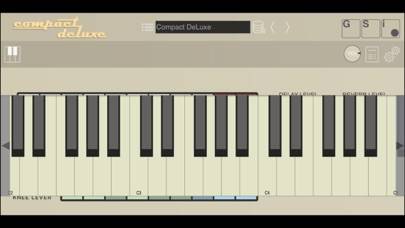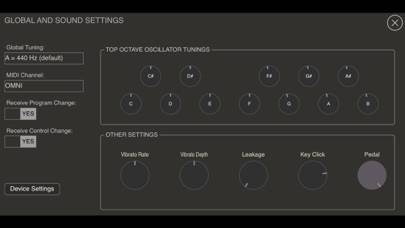Comment supprimer Compact DeLuxe
Publié par : Genuine SoundwareDate de sortie : May 16, 2023
Besoin d'annuler votre abonnement Compact DeLuxe ou de supprimer l'application ? Ce guide fournit des instructions étape par étape pour les iPhones, les appareils Android, les PC (Windows/Mac) et PayPal. N'oubliez pas d'annuler au moins 24 heures avant la fin de votre essai pour éviter des frais.
Guide pour annuler et supprimer Compact DeLuxe
Table des matières:



Compact DeLuxe Instructions de désabonnement
Se désinscrire de Compact DeLuxe est simple. Suivez ces étapes en fonction de votre appareil :
Annulation de l'abonnement Compact DeLuxe sur iPhone ou iPad :
- Ouvrez l'application Paramètres.
- Appuyez sur votre nom en haut pour accéder à votre identifiant Apple.
- Appuyez sur Abonnements.
- Ici, vous verrez tous vos abonnements actifs. Trouvez Compact DeLuxe et appuyez dessus.
- Appuyez sur Annuler l'abonnement.
Annulation de l'abonnement Compact DeLuxe sur Android :
- Ouvrez le Google Play Store.
- Assurez-vous que vous êtes connecté au bon compte Google.
- Appuyez sur l'icône Menu, puis sur Abonnements.
- Sélectionnez Compact DeLuxe et appuyez sur Annuler l'abonnement.
Annulation de l'abonnement Compact DeLuxe sur Paypal :
- Connectez-vous à votre compte PayPal.
- Cliquez sur l'icône Paramètres.
- Accédez à Paiements, puis à Gérer les paiements automatiques.
- Recherchez Compact DeLuxe et cliquez sur Annuler.
Félicitations! Votre abonnement Compact DeLuxe est annulé, mais vous pouvez toujours utiliser le service jusqu'à la fin du cycle de facturation.
Comment supprimer Compact DeLuxe - Genuine Soundware de votre iOS ou Android
Supprimer Compact DeLuxe de l'iPhone ou de l'iPad :
Pour supprimer Compact DeLuxe de votre appareil iOS, procédez comme suit :
- Localisez l'application Compact DeLuxe sur votre écran d'accueil.
- Appuyez longuement sur l'application jusqu'à ce que les options apparaissent.
- Sélectionnez Supprimer l'application et confirmez.
Supprimer Compact DeLuxe d'Android :
- Trouvez Compact DeLuxe dans le tiroir de votre application ou sur l'écran d'accueil.
- Appuyez longuement sur l'application et faites-la glisser vers Désinstaller.
- Confirmez pour désinstaller.
Remarque : La suppression de l'application n'arrête pas les paiements.
Comment obtenir un remboursement
Si vous pensez avoir été facturé à tort ou si vous souhaitez un remboursement pour Compact DeLuxe, voici la marche à suivre :
- Apple Support (for App Store purchases)
- Google Play Support (for Android purchases)
Si vous avez besoin d'aide pour vous désinscrire ou d'une assistance supplémentaire, visitez le forum Compact DeLuxe. Notre communauté est prête à vous aider !
Qu'est-ce que Compact DeLuxe ?
Victorinox sak mod compact deluxe build and the companion:
GSi Compact DeLuxe is a component modeling emulation of a Farfisa Compact DeLuxe.
INSTRUMENT BACKGROUND
Among the many transistor organs of the past, also known as "Combo Organs" (mostly because some of them also had a rhythm section and built-in speakers), the Farfisa Compact DeLuxe, along with its big brother the Compact Duo, was one of the most used organs at least in the european beat scene of the early and mid seventies. The electronic circuit of this kind of organ is relatively simple, at least on paper: rather than using a mechanical tone generator like the tonewheel models (Hammond and Pari), the transistor organs used a circuit called "Top Octave Synthesizer", TOS for short, responsible of the generation of 12 waveforms, one for each note of the last octave of the organ keyboard. The basic waveform was usually something halfway between a ramp and a triangular. The lower octaves were produced by means of "divider" circuits that could halve the frequency of each waveform, going so forth for each lower octave down to the pedalboard tones. At each division, something was lost and something was gained in terms of harmonic content. The result was that the same notes of different octaves had oscillators perfectly in sync, so all C notes were in sync, all C#, all D and so on. This same technique was also used in so-called "string machines" or "stringer keyboards" that emulated orchestral sounds (violins, trumpets, etc.) - see GSi's Electrorchestra.
The various registers in combo organs were produced by passing the raw waveforms through a filter bank, so some waveforms were low-pass filtered for bass-like sounds, some were high-pass filtered for violin-like sounds, etc. and some waveforms also went through more than one filter. This also adds some level of phase shifting between waveforms coming from different registers, the reason why the sum between, e.g. a Flute 8' and a Violin 8' isn't exactly the superimposition of the two waveforms, but something slightly different. And this is one of those underrated details that made the sound of some Combo Organs pretty unique.